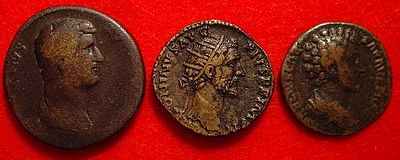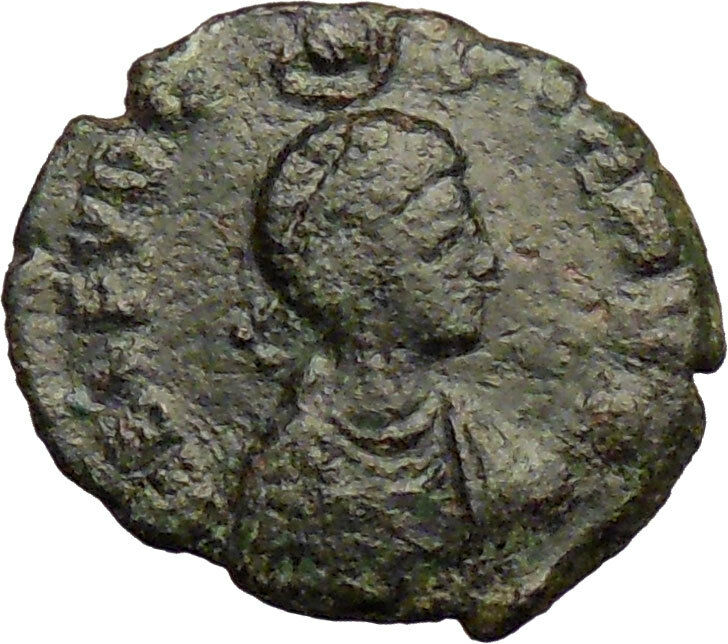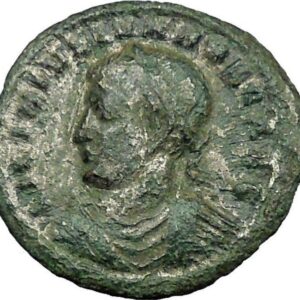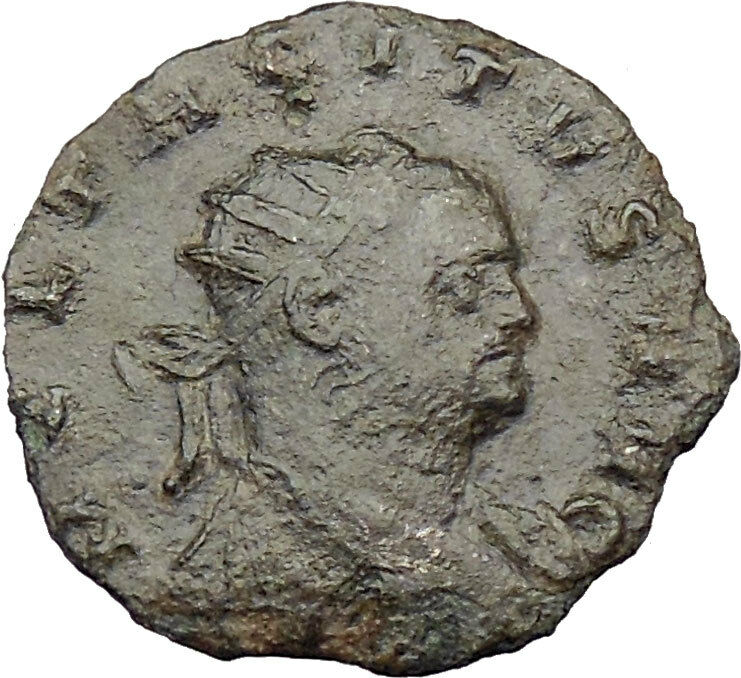|
Sabina – Roman Empress: 117-137 A.D.
Bronze Sestertius 30mm (26.43 grams) Struck in Rome mint circa 128-134 A.D.
Reference: RIC 1036 (Hadrian), C 82
SABINAAVGVSTAHADRIANIAVGPP – Diademed, draped bust right.
VESTA – Vesta seated left, holding palladium and scepter; S C across
fields.
You are bidding on the exact item pictured,
provided with a Certificate of Authenticity and Lifetime Guarantee of
Authenticity.
Vibia
Sabina (83-136/137) was a Roman Empress, wife and second cousin, once
removed, to
Roman
Emperor
Hadrian
. She was the daughter to
Salonina Matidia
(niece of Roman Emperor
Trajan
), and
suffect consul
Lucius Vibius Sabinus
. After her father’s death in 84, Sabina along with her
half-sisters lived with their grandmother, mother and were raised in the
household of Trajan, his wife
Pompeia Plotina
and her stepfather.
She married Hadrian in 100
, at the Roman Empress
Pompeia Plotina
‘s request, for Hadrian to succeed her great uncle, in 117.
Sabina’s mother Matidia (Hadrian’s second cousin) was also fond of Hadrian and
allowed him to marry her daughter.
They had no children and had an unhappy marriage. Sabina was said to have
remarked that she had taken steps to see she never had children by Hadrian
because they would “harm the human race”. It seems that she once
aborted
a
child of theirs. Sabina was strong and independent and her beliefs in marriage
didn’t sit well with the Emperor. Sabina had an affair with
Suetonius
a historian (and Hadrian’s secretary) in the year 119. In 128, she was awarded
the title of
Augusta
. Vibia Sabina died before her husband, some time in
136 or early
137.
//
Namesake
Vibia Aurelia Sabina
(170-died before 217), daughter and youngest child of
Roman Emperor
Marcus Aurelius
and Roman Empress
Faustina the Younger
was a great, great niece to Vibia Sabina. Her name was
bestowed in honor of Sabina and her father.
In
Greek
and
Roman mythology
, a
palladium
or palladion was an
image
of great antiquity on which the safety of
a city was said to depend. “Palladium” especially signified the wooden statue (xoanon)
of Pallas Athena
that
Odysseus
and
Diomedes
stole from the
citadel
of
Troy and which was later taken to the future site of
Rome by Aeneas
. The Roman story is related in
Virgil
‘s
Aeneid
and other works. In
English
, since circa 1600, the word
“palladium” has meant anything believed to provide protection or safety — a
safeguard.
Origins
The Trojan Palladium was said to be a wooden image of
Pallas
(whom the
Greeks
identified with
Athena
and the
Romans
with Minerva) and to have fallen from
heaven in answer to the prayer of
Ilus, the founder of
Troy.
“The most ancient talismanic
effigies
of Athena,”
Ruck
and
Staples
report, “…were magical found objects,
faceless pillars of Earth in the old manner, before the Goddess was
anthropomorphized
and given form through the
intervention of human intellectual meddling.”
Arrival
at Troy
The arrival at Troy of the Palladium, fashioned by Athena in remorse for the
death of Pallas, as part of the city’s
founding myth
, was variously referred to by
Greeks, from the seventh century BC onwards. The Palladium was linked to the
Samothrace mysteries
through the pre-Olympian
figure of an Elektra, mother of Dardanus, progenitor of the Trojan royal line,
and of Iasion
, founder of the Samothrace mysteries.
Whether Electra had come to Athena’s shrine of the Palladium as a pregnant
suppliant and a god cast it into the territory of Ilium, because it had been
profaned by the hands of a woman who was not a virgin, or whether Elektra
carried it herself or whether it was given directly to Dardanus vary in sources
and
scholia
. In Ilion, King
Ilus was blinded for touching the image to preserve it from a burning
temple.
Theft
During the
Trojan War
, the importance of the Palladium to
Troy was said to have been revealed to the Greeks by
Helenus
, the prophetic son of
Priam
. After Paris’ death, Helenus left the
city but was captured by Odysseus. The Greeks somehow managed to persuade the
warrior seer to reveal the weakness of Troy. The Greeks learned from Helenus,
that Troy would not fall while the Palladium, image or statue of Athena,
remained within Troy’s walls. The difficult task of stealing this sacred statue
again fell upon the shoulders of Odysseus and Diomedes. Since Troy could not be
captured while it safeguarded this image, the Greeks
Diomedes
and
Odysseus
made their way to the
citadel
in Troy by a
secret passage
and carried it off. In this way
the Greeks were then able to enter Troy and lay it waste using the deceit of the
Trojan Horse
.
Odysseus, some say, went by night to Troy, and leaving Diomedes waiting,
disguised himself and entered the city as a beggar. There he was recognized by
Helen
, who told him where the Palladium was.
Diomedes then climbed the wall of Troy and entered the city. Together, the two
friends killed several guards and one or more priests of Athena’s temple and
stole the Palladium “with their bloodstained hands”. Diomedes is generally
regarded as the person who physically removed the Palladium and carried it away
to the ships. There are several statues and many ancient drawings of him with
the Palladium.
According to the
Epic Cycle
narrative of the
Little Iliad
, on the way to the ships,
Odysseus plotted to kill Diomedes and claim the Palladium (or perhaps the credit
for gaining it) for himself. He raised his sword to stab Diomedes in the back.
Diomedes was alerted to the danger by glimpsing the gleam of the sword in the
moonlight. He disarmed Odysseus, tied his hands, and drove him along in front,
beating his back with the flat of his sword. From this action was said to have
arisen the Greek proverbial expression “Diomedes’ necessity”, applied to those
who act under compulsion. Because Odysseus was essential for the destruction of
Troy, Diomedes refrained from punishing him.
Diomedes took the Palladium with him when he left Troy. According to some
stories, he brought it to Italy. Some say that it was stolen from him on the
way.
Arrival
at Rome
According to various versions of this legend the Trojan Palladium found its
way to Athens
, or
Argos
, or
Sparta
(all in
Greece
), or
Rome in Italy
. To this last city it was either brought
by Aeneas the exiled Trojan (Diomedes, in this version, having only succeeded in
stealing an imitation of the statue) or surrendered by Diomedes himself. It was
kept there in the
Temple of Vesta
in the
Roman Forum
.
Pliny the Elder
said that
Lucius Caecilius Metellus
had been blinded by
fire when he rescued the Palladium from the
Temple of Vesta
in 241 BC, an episode alluded
to in Ovid
and
Valerius Maximus
When the controversial emperor
Elagabalus
(reigned 218-222) transferred the
most sacred relics of Roman religion from their respective shrines to the
Elagabalium
, the Palladium was among them.
In
Late Antiquity
, it was rumored that the
Palladium was transferred from Rome to
Constantinople
by
Constantine the Great
and buried under the
Column of Constantine
in his forum. Such a move
would have undermined the primacy of Rome, and was naturally seen as a move by
Constantine to legitimize his reign.
Vesta
was the
virgin
goddess of the
hearth
, home, and family in
Roman religion
. Vesta’s presence was symbolized
by the
sacred fire
that burned at her hearth and
temples.
Vesta’s (in some versions she is called Vestia) fire was guarded at her
Temples by her priestesses
, the
Vestales
. Every March 1 the fire was renewed.
It burned until 391
, when the Emperor
Theodosius I
forbade public
pagan
worship. One of the Vestales mentioned in
mythology was
Rhea Silvia
, who with the God
Mars
conceived
Romulus and Remus
(see
founding of Rome
).
The Vestales were one of the few full-time
clergy
positions in
Roman religion
. They were drawn from the
patrician
class and had to observe absolute
chastity
for 30 years. It was from this that
the Vestales were named the Vestal virgins. They could not show excessive care
of their person, and they were not allowed to let the fire go out. The Vestal
Virgins lived together in a house near the Forum (Atrium Vestae),
supervised by the
Pontifex Maximus
. On becoming a priestess, a
Vestal Virgin was legally emancipated from her father’s authority and swore a
vow of chastity for 30 years. This vow was so sacred that if it were broken, the
Vestal was buried alive in the Campus Sceleris (‘Field of Wickedness’).
It is likely that this is what happened to
Rhea Silvia
. They were also very independent
and had many privileges that normal women did not have. They could move around
the city but had to be in a carriage.
The Vestales had a strict relationship with the
rex sacrorum
and
flamen dialis
as is shown in the verses of Ovid
about their taking the februae (lanas: woolen threads) from the
king and the flamen. Their relationship with the king is also apparent in the
ritual phrase: “Vigilasne rex, vigila!” by which they apostrophated him. The
sacrality of their functions is well compounded by Cicero’s opinion that without
them Rome could not exist as it would not be able to keep contact with gods.
A peculiar duty of the vestals was the preparation and conservation of the
sacred salamoia
muries
used for the savouring of the mola
or mola salsa
, dough to be spread on sacrificial
victims, a procedure known as
immolation
. This dough too was prepared by them
on fixed days. Theirs also the task of preparing the
suffimen
for the
Parilia
.

Temple of Vesta in Italy
The sestertius, or sesterce, (pl. sestertii) was an
ancient Roman
coin. During the
Roman Republic
it was a small,
silver
coin issued only on rare occasions.
During the
Roman Empire
it was a large
brass
coin.

Helmed Roma head right, IIS behind
Dioscuri
riding right, ROMA in linear frame
below. RSC4, C44/7, BMC13.
The name sestertius (originally semis-tertius) means “2 ½”, the
coin’s original value in
asses
, and is a combination of semis
“half” and tertius “third”, that is, “the third half” (0 ½ being the
first half and 1 ½ the second half) or “half the third” (two units
plus half the third unit, or halfway between the second unit and
the third). Parallel constructions exist in
Danish
with halvanden (1 ½),
halvtredje (2 ½) and halvfjerde (3 ½). The form sesterce,
derived from
French
, was once used in preference to the
Latin form, but is now considered old-fashioned.
It is abbreviated as (originally IIS).

Example of a detailed portrait of
Hadrian
117 to 138
History
The sestertius was introduced c. 211 BC as a small
silver
coin valued at one-quarter of a
denarius
(and thus one hundredth of an
aureus
). A silver denarius was supposed to
weigh about 4.5 grams, valued at ten grams, with the silver sestertius valued at
two and one-half grams. In practice, the coins were usually underweight.
When the denarius was retariffed to sixteen asses (due to the gradual
reduction in the size of bronze denominations), the sestertius was accordingly
revalued to four asses, still equal to one quarter of a denarius. It was
produced sporadically, far less often than the denarius, through 44 BC.

Hostilian
under
Trajan Decius
250 AD
In or about 23 BC, with the coinage reform of
Augustus
, the denomination of sestertius was
introduced as the large brass denomination. Augustus tariffed the value of the
sestertius as 1/100 Aureus
. The sestertius was produced as the
largest brass
denomination until the late 3rd century
AD. Most were struck in the mint of
Rome but from AD 64 during the reign of
Nero (AD 54–68) and
Vespasian
(AD 69–79), the mint of
Lyon (Lugdunum), supplemented production. Lyon sestertii can
be recognised by a small globe, or legend stop), beneath the bust.[citation
needed]
The brass sestertius typically weighs in the region of 25 to 28 grammes, is
around 32–34 mm in diameter and about 4 mm thick. The distinction between
bronze
and brass was important to the Romans.
Their name for brass
was
orichalcum
, a word sometimes also spelled
aurichalcum (echoing the word for a gold coin, aureus), meaning
‘gold-copper’, because of its shiny, gold-like appearance when the coins were
newly struck (see, for example
Pliny the Elder
in his Natural History
Book 34.4).
Orichalcum
was considered, by weight, to be
worth about double that of bronze. This is why the half-sestertius, the
dupondius
, was around the same size and weight
as the bronze as, but was worth two asses.
Sestertii continued to be struck until the late 3rd century, although there
was a marked deterioration in the quality of the metal used and the striking
even though portraiture remained strong. Later emperors increasingly relied on
melting down older sestertii, a process which led to the zinc component being
gradually lost as it burned off in the high temperatures needed to melt copper (Zinc
melts at 419 °C, Copper
at 1085 °C). The shortfall was made up
with bronze and even lead. Later sestertii tend to be darker in appearance as a
result and are made from more crudely prepared blanks (see the
Hostilian
coin on this page).
The gradual impact of
inflation
caused by
debasement
of the silver currency meant that
the purchasing power of the sestertius and smaller denominations like the
dupondius and as was steadily reduced. In the 1st century AD, everyday small
change was dominated by the dupondius and as, but in the 2nd century, as
inflation bit, the sestertius became the dominant small change. In the 3rd
century silver coinage contained less and less silver, and more and more copper
or bronze. By the 260s and 270s the main unit was the double-denarius, the
antoninianus
, but by then these small coins
were almost all bronze. Although these coins were theoretically worth eight
sestertii, the average sestertius was worth far more in plain terms of the metal
they contained.
Some of the last sestertii were struck by
Aurelian
(270–275 AD). During the end of its
issue, when sestertii were reduced in size and quality, the
double sestertius
was issued first by
Trajan Decius
(249–251 AD) and later in large
quantity by the ruler of a breakaway regime in the West called
Postumus
(259–268 AD), who often used worn old
sestertii to
overstrike
his image and legends on. The double
sestertius was distinguished from the sestertius by the
radiate crown
worn by the emperor, a device
used to distinguish the dupondius from the as and the antoninianus from the
denarius.
Eventually, the inevitable happened. Many sestertii were withdrawn by the
state and by forgers, to melt down to make the debased antoninianus, which made
inflation worse. In the coinage reforms of the 4th century, the sestertius
played no part and passed into history.

Sestertius of
Hadrian
, dupondius of
Antoninus Pius
, and as of
Marcus Aurelius
As a unit of account
The sestertius was also used as a standard unit of account, represented on
inscriptions with the monogram HS. Large values were recorded in terms of
sestertium milia, thousands of sestertii, with the milia often
omitted and implied. The hyper-wealthy general and politician of the late Roman
Republic,
Crassus
(who fought in the war to defeat
Spartacus
), was said by Pliny the Elder to have
had ‘estates worth 200 million sesterces’.
A loaf of bread cost roughly half a sestertius, and a
sextarius
(~0.5 liter) of
wine anywhere from less than half to more than 1 sestertius. One
modius
(6.67 kg) of
wheat
in 79 AD
Pompeii
cost 7 sestertii, of
rye
3 sestertii, a bucket 2 sestertii, a tunic 15 sestertii, a donkey 500 sestertii.
Records from Pompeii
show a
slave
being sold at auction for 6,252
sestertii. A writing tablet from
Londinium
(Roman
London
), dated to c. 75–125 AD, records the
sale of a Gallic
slave girl called Fortunata for 600
denarii, equal to 2,400 sestertii, to a man called Vegetus. It is difficult to
make any comparisons with modern coinage or prices, but for most of the 1st
century AD the ordinary
legionary
was paid 900 sestertii per annum,
rising to 1,200 under
Domitian
(81-96 AD), the equivalent of 3.3
sestertii per day. Half of this was deducted for living costs, leaving the
soldier (if he was lucky enough actually to get paid) with about 1.65 sestertii
per day.
Perhaps a more useful comparison is a modern salary: in 2010 a private
soldier in the US Army (grade E-2) earned about $20,000 a year.
Numismatic value

A sestertius of
Nero
, struck at
Rome
in 64 AD. The reverse depicts
the emperor on horseback with a companion. The legend reads DECVRSIO,
‘a military exercise’. Diameter 35mm
Sestertii are highly valued by
numismatists
, since their large size gave
caelatores (engravers) a large area in which to produce detailed portraits
and reverse types. The most celebrated are those produced for
Nero (54-68 AD) between the years 64 and 68 AD, created by some of
the most accomplished coin engravers in history. The brutally realistic
portraits of this emperor, and the elegant reverse designs, greatly impressed
and influenced the artists of the
Renaissance
. The series issued by
Hadrian
(117-138 AD), recording his travels
around the Roman Empire, brilliantly depicts the Empire at its height, and
included the first representation on a coin of the figure of
Britannia
; it was revived by
Charles II
, and was a feature of
United Kingdom
coinage until the
2008 redesign
.
Very high quality examples can sell for over a million
dollars
at auction as of 2008, but the coins
were produced in such colossal abundance that millions survive.
|















